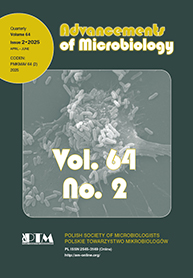Bioremediacja związków ropopochodnych oraz szlaki ich biodegradacji
1. Wprowadzenie. 2. Źródła i sposoby rozprzestrzeniania się zanieczyszczeń w glebie 3. Metody biodegradacji związków ropopochodnych 4. Mikroorganizmy genetycznie modyfikowane biorące udział w degradacji związków ropopochodnych 5. Mechanizmy biodegradacji węglowodorów ropopochodnych 5.1. Intradiolowe rozszczepienie pierścienia aromatycznego (typu „orto”) 5.2. Ekstradiolowe rozszczepienie pierścienia aromatycznego (typu „meta”)
Abstract: In recent years, crude oil and its derivatives are one of the main sources of water pollution and land in Poland. Among the chemical compounds the most toxic and carcinogenic effects on living organisms have polycyclic aromatic hydrocarbons and compounds such as benzene, toluene, ethylbenzene, xylenes (BTEX). Biotechnological methods, using hydrocarbon-degrading bacteria seem to be the most justified for environmental reasons and economic considerations. This technology is the introduction of suitable strains
of bacteria and providing mineral and organic substances necessary for life to microorganisms exist and then a rapid multiplication of microorganisms in the soil. Great importance in removing xenobiotics from the environment gained in recent years by biological and biochemical methods. Development of science and a deeper understanding of biochemical mechanisms related to the disposal of organic waste by different microbes allows the use of specialized bacteria, fungi and plants to combat waste. Biodegradation pathways are constantly known. Particular attention is given to mixtures of compounds of microbial degradation of artificially produced by man, which naturally do not occur in nature. Progressive accumulation of toxic mixtures in the environment is harmful to biological systems. Study of degradation pathways of these compounds often leads to recognition of new enzyme reactions. Due to the large variety of degradative pathways, it seems an interesting presentation of known microbial degradation pathways of alkanes and the characteristics of their key enzymes. Understanding the mechanisms of decomposition of these compounds will enable a better use of microorganisms in the remediation of contaminated environments.
1. Introduction. 2. Sources and methods of the contaminants spread in soil. 3. Methods of petroleum compounds biodegradation. 4. Genetically modified micro-organisms involved in the degradation of petroleum compounds. 5. Mechanisms of biodegradation of petroleum hydrocarbons. 5.1. Intradiolic cleavage of the aromatic ring (such as “ortho”). 5.2. Extradiolic cleavage of the aromatic ring (such as “meta”)

